| ||||||||||||||||
Presidential election | ||||||||||||||||
| ||||||||||||||||
| ||||||||||||||||
 |
|---|
General elections were held in Palau on 7 November 2000. Thomas Remengesau Jr. was elected president, whilst Sandra Pierantozzi was elected vice president. [1]
| ||||||||||||||||
Presidential election | ||||||||||||||||
| ||||||||||||||||
| ||||||||||||||||
 |
|---|
General elections were held in Palau on 7 November 2000. Thomas Remengesau Jr. was elected president, whilst Sandra Pierantozzi was elected vice president. [1]
| Candidate | Votes | % |
|---|---|---|
| Thomas Remengesau Jr. | 5,596 | 53.20 |
| Peter Sugiyama | 4,922 | 46.80 |
| Total | 10,518 | 100.00 |
| Valid votes | 10,518 | 97.90 |
| Invalid/blank votes | 226 | 2.10 |
| Total votes | 10,744 | 100.00 |
| Registered voters/turnout | 13,239 | 81.15 |
| Source: Psephos | ||
Sandra Pierantozzi was elected vice president with 52% of the vote, defeating her nephew Alan Seid, who received 45% of the vote. [2] [3]
| Party | Seats | +/– | |
|---|---|---|---|
| Independents | 9 | –5 | |
| Total | 9 | –5 | |
| Source: IPU | |||
| Party | Seats | +/– | |
|---|---|---|---|
| Independents | 16 | 0 | |
| Total | 16 | 0 | |
| Source: IPU | |||
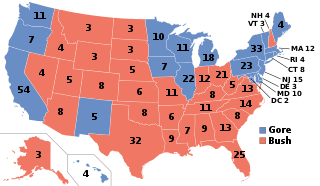
The 2000 United States presidential election was the 54th quadrennial presidential election, held on Tuesday, November 7, 2000. The Republican nominee, Governor George W. Bush of Texas, the eldest son of George H. W. Bush, narrowly defeated incumbent Democratic Vice President Al Gore. It was the fourth of five U.S. presidential elections, and the first since 1888, in which the winning candidate lost the popular vote, and is considered one of the closest U.S. presidential elections, with long-standing controversy about the result. Gore conceded the election on December 13.

The vice president of the United States (VPOTUS) is the second-highest office in the executive branch of the U.S. federal government, after the president of the United States, and ranks first in the presidential line of succession. The vice president is also an officer in the legislative branch, as the president of the Senate. In this capacity, the vice president is empowered to preside over the United States Senate, but may not vote except to cast a tie-breaking vote. The vice president is indirectly elected at the same time as the president to a four-year term of office by the people of the United States through the Electoral College, but the electoral votes are cast separately for these two offices. Following the passage in 1967 of the Twenty-fifth Amendment to the US Constitution, a vacancy in the office of vice president may be filled by presidential nomination and confirmation by a majority vote in both houses of Congress.

The president pro tempore of the United States Senate is the second-highest-ranking official of the United States Senate, after the vice president. According to Article One, Section Three of the United States Constitution, the vice president of the United States is the president of the Senate, and the Senate must choose a president pro tempore to act in the vice president's absence.

In the United States, the Electoral College is the group of presidential electors that is formed every four years during the presidential election for the sole purpose of voting for the president and vice president. The process is described in Article II of the U.S. Constitution. The number of electoral votes a state has equals its number of Senators (2) plus its number of Representatives in the House of Representatives, the latter being dependent on the Census's reported population. Each state appoints electors using legal procedures determined by its legislature, equal in number to its congressional delegation totaling 535 electors in the 50 states. A 1961 amendment granted the federal District of Columbia three electors. Federal office holders, including senators and representatives, cannot be electors. Of the current 538 electors, a simple majority of 270 or more electoral votes is required to elect the president and vice president. If no candidate achieves a majority there, a contingent election is held by the House of Representatives to elect the president and by the Senate to elect the vice president.
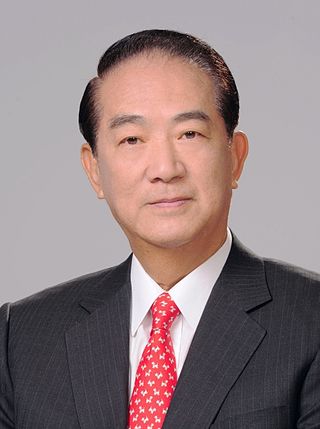
James Soong Chu-yu is a Taiwanese politician who is the founder and current Chairman of the People First Party. Soong was the first and only elected Governor of Taiwan Province from 1994 and 1998. He was a candidate in the 2000 presidential election, which he lost to Chen Shui-bian of the Democratic Progressive Party (DPP).

Elias Camsek Chin is a Palauan politician. He served as the Vice President of Palau from 1 January 2005 to 15 January 2009. He was elected as the president of the Senate of Palau from 16 January 2013 to 19 January 2017.
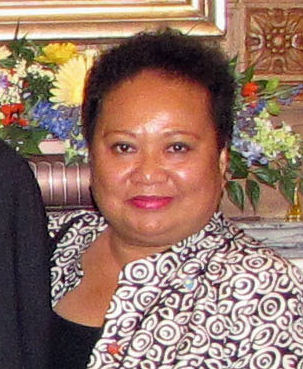
Sandra Sumang Pierantozzi is a Palauan politician. She served as the country's Vice-President from 19 January 2001 to 1 January 2005. Pierantozzi was defeated by Camsek Chin in the 2 November 2004 vice-presidential election, winning only 28.9% of the vote.
Sandra Feldman was an American educator and labor leader who served as president of the American Federation of Teachers (AFT) from 1997 to 2004.
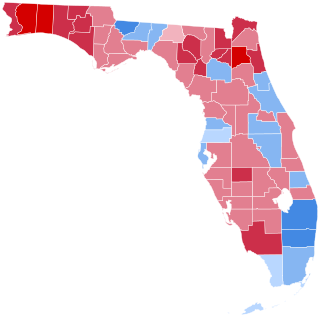
The 2000 United States presidential election in Florida took place on November 7, 2000, as part of the nationwide presidential election. Florida, a swing state, had a major recount dispute that took center stage in the election. The outcome of the 2000 United States presidential election was not known for more than a month after balloting because of the extended process of counting and recounting Florida's presidential ballots. State results tallied on election night gave 246 electoral votes to Republican nominee Texas Governor George W. Bush and 255 to Democratic nominee Vice President Al Gore, with New Mexico (5), Oregon (7), and Florida (25) too close to call that evening. Gore won New Mexico and Oregon over the following few days, but the result in Florida was decisive, regardless of how those two states had voted.
The president-elect of the United States is the candidate who has presumptively won the United States presidential election and is awaiting inauguration to become the president. There is no explicit indication in the U.S. Constitution as to when that person actually becomes president-elect, although the Twentieth Amendment uses the term "president-elect", thus giving the term "president-elect" constitutional justification. It is assumed the Congressional certification of votes cast by the Electoral College of the United States – occurring after the third day of January following the swearing-in of the new Congress, per provisions of the Twelfth Amendment – unambiguously confirms the successful candidate as the official "president-elect" under the U.S. Constitution. As an unofficial term, president-elect has been used by the media since at least the latter half of the 19th century, and was in use by politicians since at least the 1790s. Politicians and the media have applied the term to the projected winner, even on election night, and very few who turned out to have lost have been referred to as such.

Sandra L. "Sandy" Pappas is a Minnesota politician and former President of the Minnesota Senate. A member of the Minnesota Democratic–Farmer–Labor Party (DFL), she represents District 65, which includes parts of Saint Paul in Ramsey County in the Twin Cities metropolitan area.

The 2000 United States elections were held on November 7, 2000. Republican Governor George W. Bush of Texas defeated Democratic Vice President Al Gore of Tennessee in the presidential election. Republicans retained control of both houses of Congress, giving the party unified control of Congress and the presidency for the first time since the 1954 elections.

The election of the president and the vice president of the United States is an indirect election in which citizens of the United States who are registered to vote in one of the fifty U.S. states or in Washington, D.C., cast ballots not directly for those offices, but instead for members of the Electoral College. These electors then cast direct votes, known as electoral votes, for president, and for vice president. The candidate who receives an absolute majority of electoral votes is then elected to that office. If no candidate receives an absolute majority of the votes for president, the House of Representatives elects the president; likewise if no one receives an absolute majority of the votes for vice president, then the Senate elects the vice president.

The 2000 United States presidential election in Connecticut took place on November 7, 2000, and was part of the 2000 United States presidential election. Voters chose eight representatives, or electors to the Electoral College, who voted for president and vice president.

General elections were held in Guatemala on 11 September 2011 in order to elect the president, vice president, members of Congress, members of the Central American Parliament and mayors and councillors for all municipalities. The Patriotic Party emerged as the largest party in Congress, winning 56 of the 158 seats.
General elections were held in Palau on 6 November 2012. Former president Tommy Remengesau defeated his successor, incumbent Johnson Toribiong, who had been elected in 2008. Antonio Bells was elected vice-president, defeating Kerai Mariur, who had finished first in the primary elections on 26 September.
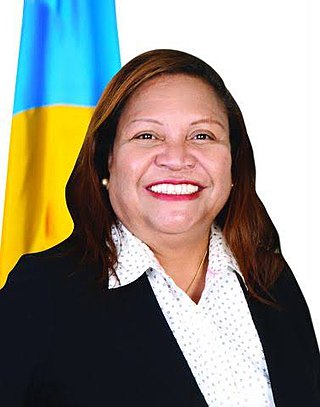
Women in Palau, known also as Palauan women, Belauan women, Pelew women, or Women of Los Palaos Islands are women who live in or are from Palau. Historically, there was a strong "gendered division of labor" between women and men of Palau.

General elections were held in Palau on 1 November 2016 to elect a President and the National Congress. Incumbent President Tommy Remengesau was challenged by his brother-in-law, Surangel Whipps Jr. for the presidency, emerging as the top two in the primary elections on 27 September. Remengesau was subsequently re-elected with 51% of the vote.

Richard Lehoux is a Canadian politician who has served as the member of Parliament (MP) for Beauce since 2019, as a member of the Conservative Party. Prior to his election to the House of Commons, Lehoux was the mayor of Saint-Elzear from 1998 to 2017 and the reeve of Nouvelle-Beauce Regional County Municipality from 2000 to 2017.